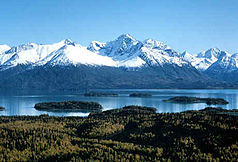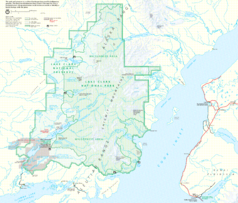Lake Clark National Park
| Lake Clark National Park | ||
|---|---|---|
| Lake Clark | ||
|
|
||
| Location: | Alaska , United States | |
| Next city: | Anchorage | |
| Surface: | 10,602.02 km² | |
| Founding: | 2nd December 1980 | |
| Visitors: | 14,479 (2018) | |
| Address: | Lake Clark National Park | |
The Lake Clark National Park ( English Lake Clark National Park and Preserve ) is a national park of the USA in Alaska . It was founded in 1980 under the Alaska National Interest Lands Conservation Act . The Preserve is on the World Conservation Union in Category II ( National Park out).
In the park area is in the Chigmit Mountains , the Alaska Range , the mountain range of central Alaska, in the Aleutian Range on that over the Aleutian Islands continues -Inselbogen. The Aleutian chain includes active volcanoes , including the two highest mountains in the park, Mount Redoubt (3059 m) and Mount Iliamna (3054 m). In the mountains there is a large number of glaciers , streams, rivers and lakes. The eponymous Lake Clark is the largest lake in the area and an important spawning area for sockeye salmon . Other lakes in the national park are the Twin Lakes , Turquoise Lake and Kontrashibuna Lake .
The park includes 200 km of coastline on Cook Inlet , the elongated bay between the Kenai Peninsula and the mainland.
Clark Lake National Park and Preserve is a total of 16,300 km², the area being composed of 10,600 km² for the actual national park and 5700 km² for the National Preserve . The Preserve has a lower protection status, hunting is permitted in it, but it has no tourist facilities or marked trails and it is administered with the National Park by the National Park Service .
The park is not connected to the road network and can only be reached by plane or by boat in the coastal strip. On average, fewer than 5000 people visit the area each year. One of the park's attractions is a log cabin on the banks of the Twin Lakes, in which the dropout Richard Proenneke lived from 1968 to 1999 and which he built himself.
Web links
- National Park Service: Lake Clark National Park (official site; English)
- Cultural Resources of Lake Clark National Park and Preserve (English)





